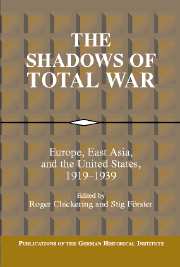Book contents
- Frontmatter
- Introduction
- Part One Reflections on the Interwar Period
- Part Two Legacies of the Great War
- Part Three Visions of the Next War
- Part Four Projections and Practice
- 13 “Not by Law but by Sentiment”: Great Britain and Imperial Defense, 1918-1939
- 14 “Blitzkrieg” or Total War?: War Preparations in Nazi Germany
- 15 The Condor Legion: An Instrument of Total War?
- 16 Stalinism as Total Social War
- 17 Total Colonial Warfare: Ethiopia
- 18 Japan’s Wartime Empire in China
- Index
15 - The Condor Legion: An Instrument of Total War?
Published online by Cambridge University Press: 05 January 2013
- Frontmatter
- Introduction
- Part One Reflections on the Interwar Period
- Part Two Legacies of the Great War
- Part Three Visions of the Next War
- Part Four Projections and Practice
- 13 “Not by Law but by Sentiment”: Great Britain and Imperial Defense, 1918-1939
- 14 “Blitzkrieg” or Total War?: War Preparations in Nazi Germany
- 15 The Condor Legion: An Instrument of Total War?
- 16 Stalinism as Total Social War
- 17 Total Colonial Warfare: Ethiopia
- 18 Japan’s Wartime Empire in China
- Index
Summary
The affinity between the concepts of “total war” and “total mobilization” was evident in Nazi ideology from the early 1930s. In fact, the linkage between these two ideas underlay the alliance between the Nazi regime and a critical portion of the German military establishment. In 1935, in his preface to the German edition of Giulio Douhet's book on total air war, Il dominio dell' aria, Hilmer Freiherr von Bülow of the Air Command Office (Luftkommandoamt, later the Luftwaffe's general staff), wrote that Douhet's attacks on the bastions of the old principles of warfare were the military equivalent of the Fascist's March on Rome; both were a reflection of the fascist revolution. Some German writers had already drawn a similar conclusion about the “German revolution.” In May 1933 Erhard Milch, the state secretary in the Ministry of Aviation, submitted to Hermann Göring, his boss, a memorandum on the German air force. This document had been prepared by Robert Knauss, the transportation director of Lufthansa and later the commander of the Air War Academy in Berlin. In it Knauss referred to “concentrations of millions of people in large cities” as legitimate targets of air warfare. “Terrorizing enemy capitals or industrial areas will lead more rapidly to a collapse of morale,” he wrote, “if the national consciousness of the population is weak and the masses in the big cities have become materialistic and divided by social and partisan conflicts.” This prediction reflected the Nazis' belief in the superiority of the German “ethnic community” (Volksgemeinschaft) over Western democratic societies.
- Type
- Chapter
- Information
- The Shadows of Total WarEurope, East Asia, and the United States, 1919–1939, pp. 285 - 294Publisher: Cambridge University PressPrint publication year: 2003



